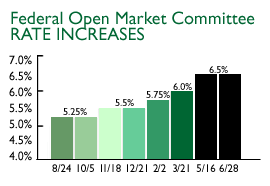|
Greenspan warily upbeat
|
 |
July 20, 2000: 10:23 a.m. ET
Fed Chief suggests U.S. economy is starting to slow; inflation may moderate
By Staff Writer M. Corey Goldman
|
NEW YORK (CNNfn) - The U.S. economy is beginning to exhibit signs of slowing, but it is too soon to conclude that the slowdown is entrenched enough to keep inflation from accelerating, Federal Reserve Chairman Alan Greenspan said Thursday.
Delivering his twice-annual monetary policy report to Congress, Greenspan said softening U.S. consumer spending may help bring demand back into line with the economy's potential to produce. But he also warned that tight labor markets and rising energy prices still might stoke inflation.
 "It is much too soon to conclude that these concerns are behind us," Greenspan said in his prepared remarks to the Senate Banking Committee. "We cannot yet be sure that the slower expansion of domestic final demand, at a pace more in line with potential supply, will persist." "It is much too soon to conclude that these concerns are behind us," Greenspan said in his prepared remarks to the Senate Banking Committee. "We cannot yet be sure that the slower expansion of domestic final demand, at a pace more in line with potential supply, will persist."
Greenspan "acknowledged unambiguously that there is not yet enough data to be sure growth has slowed in a sustained way," said Ian Shepherdson, chief U.S. economist of High Frequency Economics. "But his willingness to dig deep to find possible reasons why it might have suggests he is ready to wait before raising rates again."
Walking a tightrope
Why will Greenspan and Co. wait? Because of recent economic reports showing tame job growth, lackluster retail sales, subdued housing sales and construction and tame price increases at the wholesale and retail level.
"If the incoming data remain relatively soft, including the inflation data, the Fed will take a pass in August," echoed Sherry Cooper, chief economist with BMO Nesbitt Burns Inc. "Even if they do raise rates, it may well be the end of the tightening cycle, which is very good news for the stock and bond markets."
 That's certainly how investors saw it. Bond and stock investors alike interpreted his remarks to mean that the Fed will keep a vigilant eye on the economy, but likely will hold off raising rates next month, choosing instead to wait to see how its six rate increases implemented during the past 12 months further affect growth. The Fed last raised rates by half a percentage point on May 16 and left rates unchanged in June. That's certainly how investors saw it. Bond and stock investors alike interpreted his remarks to mean that the Fed will keep a vigilant eye on the economy, but likely will hold off raising rates next month, choosing instead to wait to see how its six rate increases implemented during the past 12 months further affect growth. The Fed last raised rates by half a percentage point on May 16 and left rates unchanged in June.
Greenspan walked his now familiar tightrope of depicting the world's largest economy as both exceptionally strong and yet exceptionally productive - productive enough to keep inflation in check, despite above-potential growth.
"Demand may be moving closer into line with the rate of advance in the economy's potential, given our continued impressive productivity growth," Greenspan said. "Should this favorable outcome prevail, the immediate threat to our prosperity from growing imbalances in our economy would abate."
Diminishing wealth effect
As for consumer spending, which accounts for roughly two-thirds of total economic output, Greenspan suggested that Americans may have spent themselves - literally - suggesting that their seemingly insatiable appetite for new homes, cars, computers, electronics and other goods may now be sated.
 "Even without the rise in interest rates, an eventual leveling out or some tapering off of purchases of durable goods and construction of single-family housing would be expected," he said. The notion that consumers may have hit a limit in their spending is a "credible addition" to other explanations for the recent drop-off in consumer purchases. "Even without the rise in interest rates, an eventual leveling out or some tapering off of purchases of durable goods and construction of single-family housing would be expected," he said. The notion that consumers may have hit a limit in their spending is a "credible addition" to other explanations for the recent drop-off in consumer purchases.
Other factors, most notably the stunning 37-percent decline in the Nasdaq composite index from its March 10 record high, along with higher levels of outstanding debt and borrowing costs that are almost 2 percent higher than they were a year ago, also are having an impact on overall growth by leaving consumers with less disposable income, even as employment remains robust, Greenspan said. (482KB WAV) (482KB AIFF)
It is premature to make any kind of definitive assessment of trends in recent household spending or what they mean, Greenspan said. "But it is clear that, for the time being at least, the increase in spending on consumer goods and houses has come down several notches, albeit from very high levels."
Thank you Bill, Larry
Stocks have tempered their gains this year after five years of double-digit increases. The Dow Jones industrial average has lost 7 percent so far this year, after recording a 25 percent gain in 1999. As of Wednesday, the Nasdaq was unchanged in 2000 after an 86 percent increase a year ago.
Greenspan also tipped his hat to President Clinton, U.S. Treasury Secretary Lawrence Summers and the rest of the administration for turning the U.S. budget deficit completely on its head into a budget surplus, thereby fostering the boom in capital spending that has fueled productivity gains.
 But he cautioned lawmakers that they should focus on continuing to build up the budget surplus, and not go on a spending spree to fund new government programs or cut taxes. "Continued fiscal discipline will contribute to maintaining robust expansion of the American economy in the future." But he cautioned lawmakers that they should focus on continuing to build up the budget surplus, and not go on a spending spree to fund new government programs or cut taxes. "Continued fiscal discipline will contribute to maintaining robust expansion of the American economy in the future."
The U.S. government is projected to post a fiscal 2000 budget surplus of $210 billion. In 1996 the budget deficit was $107.5 billion.
Fiscal discipline will also help convince international investors who already hold a significant portion of American dollar-denominated investments comfortable with investing in U.S. securities - a scenario that will help keep the value of the U.S. dollar strong.
"So long as foreigners continue to seek ever-increasing quantities of dollar investments in their portfolios, as they obviously have been, the exchange rate for the dollar will remain firm," Greenspan said.
The Fed's forecasts
"He's mentioning that the dollar should stay firm and that's been a good factor for our economy," said Gary Thayer, chief economist with A.G. Edwards and Sons in St. Louis. "He's been concerned for some time about foreign investors wanting to keep their money here and if we keep our policies in line that should hold for a while."
 Greenspan also warned that higher energy prices are pushing up inflation, and it's too soon to know whether the slowdown in consumer spending will last. "Certainly, we have seen slowdowns in spending during this near-decade-long expansion that have proven temporary," he said. Greenspan also warned that higher energy prices are pushing up inflation, and it's too soon to know whether the slowdown in consumer spending will last. "Certainly, we have seen slowdowns in spending during this near-decade-long expansion that have proven temporary," he said.
The Fed expects the economy to grow in a range of between 4 percent and 4.5 percent in 2000, "suggesting a noticeable deceleration over the second half of 2000," Greenspan said. The economy expanded at a 7.9 percent pace in the fourth quarter and at a 5.4 percent clip in the first quarter.
Gross domestic product is expected to decelerate even further in 2001, slipping to a range of 3.25 percent-to-3.5 percent, "given the firmer financial conditions that have developed over the past 18 months," he said. The Fed embarked on its inflation-fighting rate in June 1999; a quarter-point hike typically takes 12-to-18 months to filter its way into the economy.
Greenspan and his colleagues on the Open Market Committee also forecast that the unemployment rate will hold steady around 4 percent for the rest of this year and next, while inflation as measured by prices of personal consumption expenditures will rise to between 2.5 percent and 2.75 percent this year, before easing back to a 2 percent-to-2.5 percent level next year. 
|
|
|
|
|
|
U.S. Federal Reserve
|
Note: Pages will open in a new browser window
External sites are not endorsed by CNNmoney
|
|
|
|
 |

|

